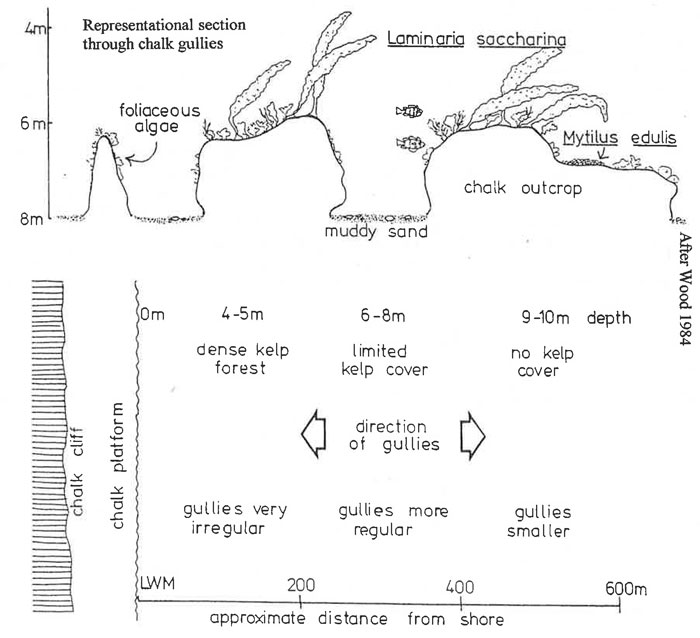SUSSEX MARINE SITES OF NATURE CONSERVATION IMPORTANCE
| Site: Subtidal wave-cut chalk platform (Hope Point-Beachy Head) | Ref. No. 22 | ||||||
| Location: Adjacent to the Seven Sisters chalk cliffs (8 km) | Other conservation designation?: No |
||||||
| Lat./Long. position of centre of site: 50° 44' 64" N 0° 10' 23" E |
OS grid ref. of centre of site: TV 531 961 |
Author: Robert Irving |
|||||
| Sea bed type: Dissected chalk platform with ridges and gullies - site extends from mid-shore to approx. 750 m seaward. |
Depth range (below chart datum): 8-1 m |
Date identified: June 2001 |
|||||
Summary
The intertidal wave-cut platform at the foot of the impressive Seven Sisters chalk cliffs extends beyond low water mark some 500 m offshore. The chalk bedrock here has been eroded to form a series of gullies and ridges which run perpendicular to the shore. The gullies are some of the best examples of their type in Sussex, if not the South East. Indeed, the subtidal gullies at Seaford Head (just to the west of this site) are considered to be the best developed in the area and were identified as an mSNCI in 1996 (ref no. 11).
Biological Description
Closest to low water mark, the chalk ridges bounding the gullies are about 1.5 m high with dense growths of stunted kelps Laminaria saccharina and L. digitata on their tops. The kelps do not extend below 2.5 m BCD. Below this, upward-facing surfaces are dominated by smaller brown and red algae such as Taonia atomaria, Calliblepharis ciliata and Ceramium rubrum. Algal cover becomes sparse below 5 m BCD and is absent below 7 m BCD. On upper surfaces of the chalk ridges, large growths of the breadcrumb sponge Halichondria panicea are present, and in less exposed places, the sponges Halichondria bowerbanki and Esperiopsis fucorum. The sides of the ridges have a covering of animal turf, made up largely of bryozoans (Bugula spp.) and hydroids, with various tubicolous worms including Sabellaria spinulosa and Pomatoceros triqueter. The lower sides of the ridges are affected by the movement of sand and pebbles from the gully floor and are often bare. There is often, however, a narrow (10-20 cm) band between the animal turf and the bare rock which is colonised by large numbers of the horseshoe worm Phoronis hippocrepia. Other major burrowing organisms in the chalk include the polychaete Polydora ciliata and the piddocks Pholas dactylus, Barnea parva and Hiatella arctica.
Common fishes associated with the gullies include tompot blenny Parablennius gattorugine, longÂspined sea scorpion Taurulus bubalis and leopard-spotted goby Thorogobius ephippiatus (near the eastern limit of its distribution here). At the seaward extent of the gullies, between 300-450 m from low water mark, the ridges are barely 30 cm high. Beyond about 500 m from the low water mark the seabed flattens out and sand predominates.
Justification
Sublittoral chalk exposures are unusual within the British Isles, with the vast majority being found in the South East. The wave-cut platform between Hope Point and Beachy Head displays excellent examples of gully and ridge topography, with their associated biological communities. The site lies within the Seven Sisters Voluntary Marine Conservation Area, and constitutes one of its main features of interest.
References:Irving, R. A. 1998. Sussex Marine Life - an identification guide for divers East Sussex Council, Lewes |
|||||||
| Sussex SEASEARCH dive nos.: Seven Sisters Marine Survey 3-8; 714/28-30, 37-39, 42,43, 103, 113, 115, 116, 118, 715/33 | |||||||
Site Location

Diagrammatic representation of site: Subtidal wave-cut chalk platform (Hope Point-Beachy Head)


:Link to this page
Copyright Sussex Biodiversity Records Centre © 2025